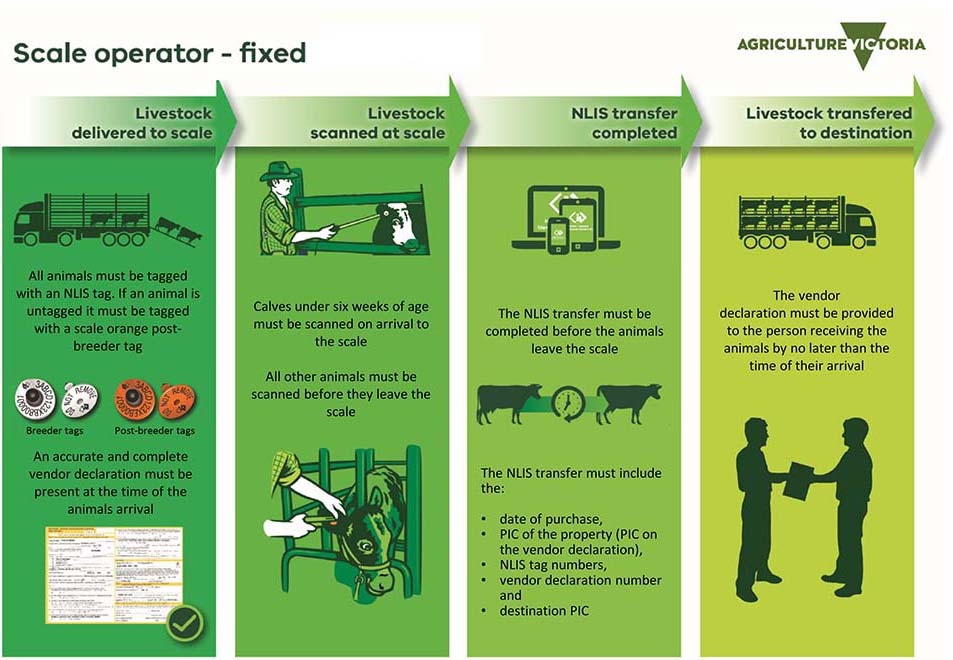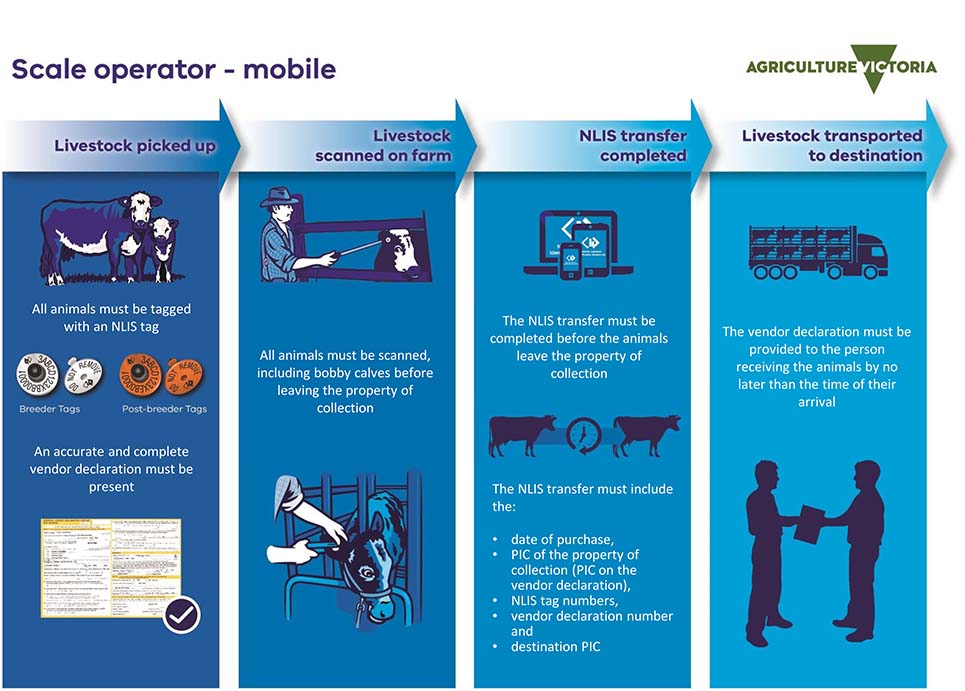Scale operator NLIS requirements
As a business involved in the congregation, transportation and mixing of livestock, it's important for scale operators to have robust traceability practices and operations that meet legislative requirements.
Scale operator traceability requirements
To reach an acceptable level of traceability, participants along the supply chain must comply with legislation associated with livestock traceability and traceability systems.
As a scale operator, it's your responsibility to:
- ensure animals are correctly tagged
- transfer livestock from and to correct PICs
- complete NLIS database transfers accurately and on time
- ensure all animals are traded with accurate vendor declarations.
All scale operators require a:
- property identification code (PIC) — this defines a property where livestock are kept. Your PIC will start with '3SC', which indicates that you run a scales business in Victoria
- EUSY code — your PIC and EUSY code will be linked. This allows you to correctly transfer animals on the NLIS database. Your EUSY code will be allocated when you get a scale PIC.
- National Livestock Identification System (NLIS) 'Saleyard' account — Scales are referred to as saleyards on the NLIS database as their uploads are the same. Apply online or call the NLIS helpdesk on 1800 654 743.
NLIS tagging requirements
When trading animals through a scale it is your responsibility as a scales operator to ensure that animals are correctly tagged. All cattle and calves must be identified with an NLIS tag.
A scale operator must tag livestock with an NLIS orange post-breeder tag (allocated to the scale) when:
- it arrives at the scale untagged
- it has a non-reading NLIS tag.
A scale operator must not apply a producer's NLIS tag to an animal that is at a scale. It is an offence against the scale operator if animals are missing tags or are incorrectly tagged when sold.
Post-breeder tags can be ordered online at tags.agriculture.vic.gov.au or by calling our NLIS Helpline on 1800 678 779.
Correct PICs used in NLIS transfers
Scale operators must transfer livestock from, and to, a correct and valid PIC.
The PIC on the National Vendor Declaration (NVD) must be used as the 'from' PIC in the NLIS transfer.
For any queries concerning PICs you can call our NLIS Helpline on 1800 678 779.
You can apply for, edit or cancel a PIC online.
NLIS scanning and transfer requirements
All livestock traded through a scale are required to be scanned and transferred on the NLIS database.
Fixed scales– Scale operators at fixed locations where producers drop off their own cattle, calves and sheep MUST scan all animals before they leave the scale (calves under six weeks of age must be scanned on arrival to the scale). The NLIS transfer MUST be completed before the animals leave the scale, including the destination PIC.
Mobile scales– Scale operators who pick up calves, cattle and sheep on farm MUST scan the animals on farm and complete the NLIS transfer before the animals leave the farm, including the destination PIC.
The following information must be uploaded to the NLIS database:
- seller/buyer PIC
- date of sale/transaction
- NLIS or RFID tag number for each animal
- serial number on the movement record or NVD
- EUSY number.
If an NLIS transfer is completed incorrectly the transfer can be edited or removed and re-uploaded. The NLIS database sends emails and alerts to inform of any errors or issues related to an NLIS upload. These emails should be monitored to ensure transfers are completed successfully and that errors or warnings are actioned, where they occur.
Current holdings
Devices that remain registered to your EUSY code and not transferred to the correct destination PIC are called 'current holdings'.
It's a legal requirement that scales operators manage current holdings and ensure that all animals being traded through the scale are transferred off the scale EUSY on the NLIS database within the legislated timeframe (by close of business the day after the sale).
Current holdings can be managed by a scale operator using an NLIS database account. Emails that list all holdings recorded against a scale's EUSY are sent by the NLIS database on a weekly basis to the email account recorded on the database.
Visit the NLIS website or call 1800 654 743 for more information about the NLIS, to sign up or to edit NLIS account details.
Ensure all animals are traded with accurate movement documents
An accurate and complete movement document must be present at the time of the animals arrival at the scale.
Animals must not be traded without a movement document.
Legislation
To reach an acceptable level of traceability, participants along the supply chain must comply with legislation associated with livestock traceability and traceability systems.
The legislation governing scale operators for NLIS and animal welfare is the:
- Livestock Disease Control Act 1994
- Livestock Disease Control Regulations 2017
- Prevention of Cruelty to Animals Act 1986
Infographic: Scale operator — fixed
Download: Scale operator — fixed (PDF - 220.4 KB)

Four panel infographic. Scale operator — fixed.
Panel 1: Livestock delivered to scale
All animals must be tagged with an NLIS tag. If an animal is untagged it must be tagged with a scale orange post breeder tag.
An accurate and complete vendor declaration must be present at the time of the animals arrival
Panel 2: Livestock scanned at scale
Calves under six weeks of age must be scanned on arrival to the scale
All other animals must be scanned before they leave the scale
Panel 3: NLIS transfer completed
The NLIS transfer must be completed before the animals leave the scale
The NLIS transfer must include the:
- date of purchase
- PIC of the property (PIC on the vendor declaration)
- NLIS tag numbers
- vendor declaration number and
- destination PIC
Panel 4: Livestock transferred to destination
The vendor declaration must be provided to the person receiving the animals by no later than the time of their arrival.
Four panel infographic. Scale operator — mobile
Panel 1: Livestock picked up
All animals must be tagged with an NLIS tag
An accurate and complete vendor declaration must be present
Panel 2: Livestock scanned on farm
All animals must be scanned, including bobby calves before leaving the property of collection
Panel 3: NLIS transfer completed
The NLIS transfer must be completed before the animals leave the property of collection
The NLIS transfer must include the:
- date of purchase
- PIC of the property of collection (PIC on the vendor declaration),
- NLIS tag numbers,
- vendor declaration number and
- destination PIC
Panel 4: Livestock transported to destination
The vendor declaration must be provided to the person receiving the animals by no later than the time of their arrival
More information on NLIS
'Traceability: your livestock, your industry, our future'
Agriculture Victoria NLIS Helpline
For more information:
- call our NLIS Helpline on 1800 678 779 between 9am and 4.30pm, Monday to Friday
- email nlis.victoria@agriculture.vic.gov.au
- visit our National Livestock Identification System page
NLIS Database Helpdesk contacts
The NLIS Database Helpdesk is operated by the Integrity Systems Company.
Call 1800 654 743 between 9am and 5pm (AEST), Monday to Friday, or email support@nlis.com.au
Factsheets
Download the fact sheets:
